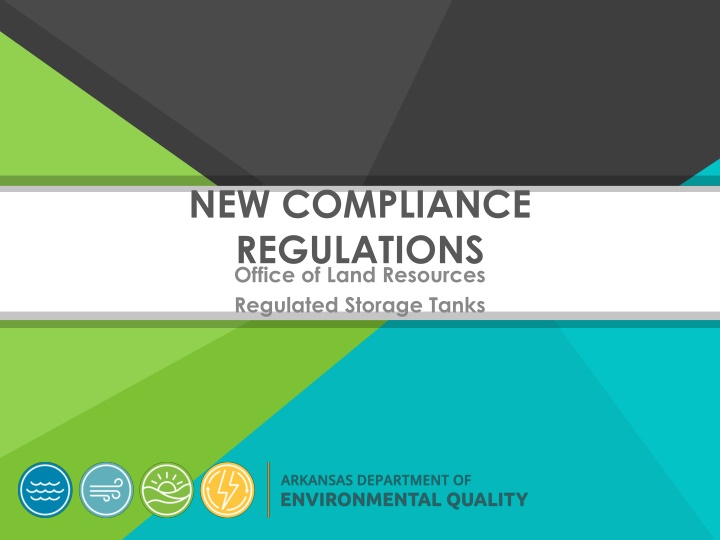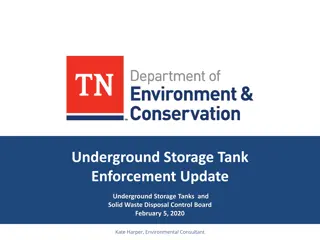Compliance Regulations for Regulated Storage Tanks
This document outlines the compliance regulations for regulated storage tanks focusing on inspection requirements including visual checks, removal of debris, and monitoring equipment to ensure safe operations. It specifies the frequency of inspections and maintenance tasks for spill prevention and release detection equipment. The guidelines emphasize annual requirements for double-walled containment sumps with interstitial monitoring. Additionally, it includes details on checking hand-held release detection equipment and conducting additional visual inspections.
Download Presentation

Please find below an Image/Link to download the presentation.
The content on the website is provided AS IS for your information and personal use only. It may not be sold, licensed, or shared on other websites without obtaining consent from the author.If you encounter any issues during the download, it is possible that the publisher has removed the file from their server.
You are allowed to download the files provided on this website for personal or commercial use, subject to the condition that they are used lawfully. All files are the property of their respective owners.
The content on the website is provided AS IS for your information and personal use only. It may not be sold, licensed, or shared on other websites without obtaining consent from the author.
E N D
Presentation Transcript
NEW COMPLIANCE REGULATIONS Office of Land Resources Regulated Storage Tanks
Facility Name: Facility ID Number: Phone Number: Facility Address: Initial each column below the date of inspection to indicate that the device/system was inspected and found to be satisfactory on that date. For those items not applicable for this facility, please indicate N/A . Keep this record for no less than one (1) year. Date of inspection (mm/dd/yy) REQUIRED EVERY 30 DAYS Visually check spill prevention equipment for damage. Remove any liquid and/or debris. Check release detection equipment to ensure it is operating with no alarms or unusual operating conditions present. For double-walled spill prevention equipment with interstitial monitoring, check for a leak in the interstitial area. Check for and remove obstructions in the fill pipe. Check the fill cap to make sure it is securely on the fill pipe. Ensure release detection records are reviewed and current. REQUIRED ANNUALLY For double-walled containment sumps with interstitial monitoring, check for leaks in the interstitial area. Visually check containment sumps for damage and leaks to the containment area or a release to the environment. Remove any liquid or debris from containment sumps. Check hand-held release detection equipment, such as groundwater bailers and tank gauge sticks, for operability and serviceability.
30-Day Walk-through Inspection Required every 30 days Visually check spill prevention equipment for damage and remove any liquid and/or debris Check release detection equipment to ensure it is operating with no alarms or unusual operating conditions present
30-Day Walk-through Inspection For double-walled spill prevention equipment with interstitial monitoring, check for a leak in the interstitial area Check for and remove obstructions in the fill pipe Check the fill cap to make sure it is securely on the fill pipe Ensure release detection records are reviewed and current
Annual Requirement For double-walled containment sumps with interstitial monitoring, check for leaks in the interstitial area Visually check containment sumps for damage and leaks to the containment area or a release to the environment Remove any liquid or debris from containment sumps
Check hand-held release detection equipment, such as groundwater bailers and tank gauge sticks, for operability and serviceability Additional visual inspection not on the check list: dispenser hoses, nozzles, damage to vent pipes Keep this record for no less than one (1) year
Annual Release Detection Equipment Testing Automatic tank gauge and other controllers Test the alarm Verify the system configuration Test the battery backup Probes and sensors Inspect for residual buildup Ensure any floats move freely
Annual Release Detection Equipment Testing Ensure shafts are not damaged Ensure the cables are free of kinks and breaks Test the alarm operability and communication with the controller Ensure probes and sensors are positioned properly
Annual Release Detection Equipment Testing Automatic line leak detector Test operation to ensure the device activates (alarms, restricts flow, or shuts off flow) within an hour when simulating a release to 3 gallons per hour at 10 pounds per square inch (psi)
Annual Release Detection Equipment Testing Vacuum pumps and pressure gauges Ensure there is proper communication with sensors and the controller Hand-held electronic sampling equipment associated with groundwater and vapor monitoring Ensure the device is calibrated and operates properly
Over-fill Prevention Equipment Testing Ball float valves Check for presence of ball Overflow prevention valves (flapper valves) Overfill alarm system Test lights and alarm
Spill Bucket and Sump Testing Three Year Spill Bucket Testing STP Sumps, and Dispenser Sumps Testing Installed after July 1, 2007 Used for release detection monitoring Must be hydrostatic tested every three years Water from testing can be reused several times before being disposed of at a recycling facility
Spill Bucket and Sump Testing 1. Visual examination 2. Water test Fill port cap is tight Use plumbers plug to prevent water entry Fill spill bucket 1 inches from the top Fill sumps four inches above the highest penetration or seam 3. Measure
Spill Bucket and Sump Testing 3. Measure To nearest 1/16 inch Wait one hour Measure again Pass = Less than 1/8 inch change Fail = 1/8 inch or greater change
Additional Topics Removal of regulatory deferral of release detection for Emergency Generator USTs New AST registration options 50 percent pipe run replacement rule
Contacts Robert Morgan Inspector Supervisor Office of Land Resources Regulated Storage Tanks 501.682.0980 morganr@adeq.state.ar.us Sam McDuffie Inspector Supervisor Office of Land Resources Regulated Storage Tanks 501.682.0973 smcduffie@adeq.state.ar.us























